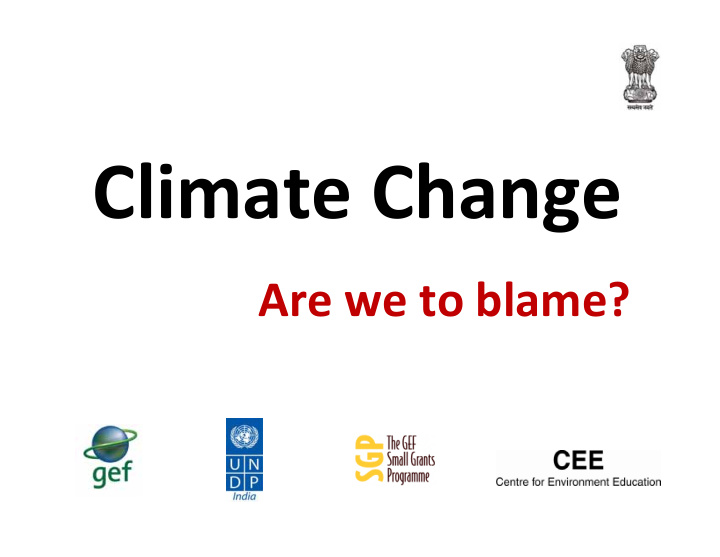



Climate Change Are we to blame?
Presentation Flow • Global changes • Climate Science Findings • Impacts on India • Underlying Causes of Climate Change
What changes are we seeing
Unusual weather events around the world Rare snow in United Rare snow in United Record high winter Mildest winter in Mildest winter in Arab Emirates, 2004 Arab Emirates, 2004 temperatures, Canada, 2005/06 Canada, 2005/06 Record snowfalls Japan 2007 in Japan, 2005/06 Extreme winter storms USA, 2011 Major heat wave Major heat wave in Europe, 2003 in Europe, 2003 Worst winter storms, China United States and United States and 2008 Central America hit by Central America hit by most devastating most devastating Heaviest Heaviest Floods in Floods in hurricanes ever, 2005 hurricanes ever, 2005 rain in a day rain in a day Algerian Algerian in Mumbai, in Mumbai, Sahara Sahara 2005 2005 Desert, 2006 Desert, 2006 Hottest year in Australia, 2005 First hurricane First hurricane Hottest year in Record breaking rain Winter heatwave in Brazil, 2004 in Brazil, 2004 Australia, 2005 Australia, 2010 Argentina, 2009 4 4
Pederson Glacier (Alaska) Glaciers are retreating
Parts of some Antarctic ice shelves are collapsing Larsen B ice shelf, Antarctica 3250 km 2 of ice, 220 m thick collapsed in 2002 Photos: NSIDC/NASA
Sea levels are rising Source: http://www.flickr.com/photos/go_greener_oz/3047060508/
Drought in many places around the world
Increase in Wildfires
All is not well All is not well
Climate Science Findings
Gases like carbon dioxide are essential for life on Earth. Source: Vital Climate Graphics, Grid Arendal / UNEP
They trap some of the heat leaving the Earth. Without them, Earth’s average temperature would be -20 0 C
natural Some are made man- some
Not only are we creating new greenhouse gases, we are adding to natural ones as well
Atmospheric CO 2 has increased from a pre-industrial concentration of about 280 ppm to about 397 ppm at present
Methane and nitrous oxide fare no better Figure: NOAA Earth System Research Laboratory
To learn more about the concentration of GHGs in the atmosphere before the era of instruments and measurements, scientists are analyzing gases trapped in ice And we find that…….
Source: http://www.flickr.com/photos/perryham/3577638548/ We’re blanketing the Earth with more and more of these gases and the ‘ball is going warm’
13.2 14.8 14
A hot future awaits us Global mean surface temperature could rise between 1-4.5 0 C by 2100
Will we be impacted?
Each one of us will be affected
Net cereal production in South Asian countries is projected to decline at least between 4 to 10% by the end of this century
The risk of hunger is likely to remain very high in India. Food costs will increase
Melting of glaciers could seriously affect 500,000,000 people served by the Himalaya-Hindu-Kush region Source: http://www.flickr.com/photos/ilker/2493908853/
Groundwater – it’s finite! 7 out of 9 districts in Delhi are over-exploited (extraction > recharge) with respect to dynamic groundwater resources
India will reach a state of water stress before 2025 This will impact food security, human health and economic activity
Precipitation patterns will change There may be more intense rainfall on rainy days, resulting in floods and more dry days in a year, causing drought Flood damage costs 350 million Indians have India an average of Rs been affected badly due 4745 crore every year to drought in a decade
Deaths due to heat waves, water borne diseases and vector borne diseases like dengue are expected to increase
Sea level will be a minimum of 40 cm higher than today by the end of 21st century Source: TERI 1996 11 % of Bangladesh's coastal land is likely go underwater, creating 7 to 10 million climate refugees
But, are we to blame? Aren’t the culprits industry and the government? The underlying causes
1940 – 2.3 billion 2050 – 9.2 billion 1940 – 2.3 billion 2050 – 9.2 billion Population is increasing but natural resources are NOT!!
Forests are becoming croplands to feed our growing millions. Fewer trees, more carbon dioxide in the atmosphere
Intensification of agriculture to feed the growing millions Global fertilizer consumption More nitrous oxide released Source: IGBP
Changing lifestyles More methane More methane generated by generated by anaerobic anaerobic decomposition decomposition of wastes in of wastes in landfills landfills Source: http://maps.grida.no/go/graphic/the-richer-we-get-the-more-we-discard-human-consumption-waste-and-living-standards Philippe Rekacewicz, UNEP/GRID-Arendal
Changing lifestyles http://www.flickr.com/photos/lingaraj/2415084235/
Increasing industrialization to meet our growing demands
Increased demand for electricity From domestic consumers From industries From the agriculture sector 0.82 kg of CO 2 produced for every unit of electricity generated from coal. That’s approx. 1 kg of CO 2 produced for every unit of electricity we use.
Energy use
It’s time to adopt a low carbon lifestyle…. Conserve fuel Reduce use of electricity Do not waste water Reduce, Reuse, Recycle
But can I make a difference? I am just one person Each one adopt at least two low ‐ carbon actions The worst can still be avoided ely and aggressively work towards being part Each one influence at least 5 others of the solution to adopt two low ‐ carbon actions and spread the message
Will it help? The impact of millions of people who choose to make changes in personal lifestyles cannot be undermined “Whatever you may do may seem insignificant to you, but it’s most important that you do it”. ‐ Mahatma Gandhi
Prepared by: Rashmi Gopal Sources: The Schools Water Portal ‐ http://schools.indiawaterportal.org/ Dr U Kelkar For more information, please contact: Prabhjot Sodhi E ‐ mail: prabhjot.sodhi@ceeindia.org Ph: 011 ‐ 26262878 – 80 Address: Centre for Environment Education C ‐ 40, South Extension –II New Delhi ‐ 110049
Recommend
More recommend